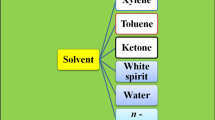Abstract
The main purpose of this study is to develop and optimize a luminescent road-marking paint to improve the visibility of the traditional used road-marking paint. This paint is produced with an emulsion of an acrylic copolymer containing a self-made modified luminescent powder and various additives. Experimental coatings were manufactured on a laboratory scale and applied using a brush on tinplate panels and asphalt concrete surface. Results found a series of properties which indicated that the paint made with the additives containing sodium hexametaphosphate and sodium carboxymethyl cellulose exhibited a satisfactory performance when mixed with silicone emulsion. The physical, mechanical and corrosion resistance was studied in order to evaluate the feasibility of application onto the road surface. The results show that the paint meets the basic performance requirements of road-marking paint and has little effect on the texture depth of the road surface. The luminous performance, abrasion resistance, adhesion and water resistance at room temperature meets the basic requirements for pavements.
Similar content being viewed by others
References
British Standard Institute, Hot-Applied Thermoplastic Road Marking Materials. BS 3262. BSI, London, UK, 1989.
S. M. Mirabedini, M. Sharifi, M. Haghayegh, S. H. Shabani, P. Bakhtiari, Blending of hydrocarbon and rosin ester-based resins to study its effect on the physical and mechanical properties of thermoplastic road markings, Iran. J. Polym. Sci. Technol. 22 (6) (2010) 457–467. https://www.sid.ir/en/Journal/ViewPaper.aspx?ID=215718.
D.L. Schmidt, Water-based acrylic coating compositions. U.S. Patent 5,470,908. Washington DC, USA, 1995.
J.W. Du, J. Hajas, W. Scholz, A. Wooker, A. Frank, M. Jadliwala, B. Weber, W. Wessels, New additive to enhance surface cleanability, Surface Coatings Inter. Part A, Coatings J. 88 (1) (2005) 18–22.
W. Heilen, S. Struck, Overcoming Substrate Wetting Problems, (SpecialChem, 2003), Paint & Coatings Industry. 19 (3) (2003) 58. http://www.specialchem4coatings.com.” Accessed 8 July 2020.
A. Carter, G. Osmond, B. Ormsby, Ian Fairweather and water-based emulsion house paints in Australia 1950–64. AICCM Bulletin 34 (1) (2013) 34–43.
D.H. Guo, Research on Application of Waterborne Marking Paint with Material Properties, Adv. Mater. Res. 700 (2013) 45–49. https://doi.org/10.4028/www.scientific.net/AMR.700.45.
Standards Australia, Sydney and Standards New Zealand, Glass beads for pavement-marking materials, AS/NZS 2009:2006. Wellington, NZ, 2016.
V. Jubera, J.P. Chaminade, A. Garcia, F. Guillen, C. Fouassier, Luminescent properties of Eu3+-activated lithium rare earth borates and oxyborates, J. Lumin. 101 (1–2) (2003) 1–10.
Y. Lin, Z. Tang, Z. Zhang, Preparation of long-afterglow Sr4Al14O25-based luminescent material and its optical properties, Mater. Lett. 51 (1) (2001) 14–18. https://doi.org/10.1016/S0167-577X(01)00257-9.
T. Liu, B. Campbell, S. Burns, J. Sullivan, Temperature and Pressure-Sensitive Luminescent Paints in Aerodynamics, Appl. Mech. Rev. 50 (1997) 227–246. https://doi.org/10.1115/h3101703.
M. Bethencourt, F.J. Botana, M.J. Cano, R.M. Osuna, M. Marcos, Lifetime prediction of waterborne acrylic paints with the AC-DC-AC method, Prog. Org. Coatings. 49 (3) (2004) 275–281. https://doi.org/10.1016/j.porgcoat.2003.10.009.
W M. Ruyten, Correction of self-illumination and spectral-leakage effects in luminescent-paint measurements, Appl. Optics 36 (14) (1997) 3079–3085.
W. Li, J. Wang, Y. Xie, M. Tebyetekerwa, Z. Qiu, J. Tang, S. Yang, M. Zhu, Z. Xu, Water-based fluorescent paint: Presenting a novel approach to study and solve the aggregation caused quench (ACQ) effect in traditional fluorescent materials, Prog. Org. Coatings. 120 (2018) 1–9. https://doi.org/10.1016/j.porgcoat.2018.03.003.
I. Anders, Phosphorescent highway paint composition: US, US 5472737 A[P]. Washington DC, USA, 1995.
Y.J. Zhang, S.L. Tan, J.C. Lang, S.U. Shi-Min, A novel water-based acrylic luminescent coating with long-lasting photolumin escence, J. Funct. Mater. Devices. 8 (4) (2002) 415–417.
China Standard Press, General preparation of paint film. GB/1727. Beijing, China, 1992.
China Standard Press, Test method for building sealants Part 5: Determination for tack-free time. GB/T 1728. Beijing, China, 2002.
China Standard Press, Paints and varnishes -Determination of film hardness by pencil test. GB/T6739. Beijing, China, 2006.
China Standard Press, Determination of resistance to water of films. GB/T 1733. Beijing, China, 1993.
China Standard Press, Determination of resistance to chemical reagents of films. GB/T 1763. Beijing, China, 1989.
China Standard Press, Paints and varnishes- Cross cut test for films. GB/T 9286. Beijing, China, 1998.
China Standard Press, Paints and varnishes-Determination of film thickness. GB/T13452.2. Beijing, China, 2008.
P.A. Clausen, Emission Of Volatile And Semivolatile Organic Compounds From Waterborne Paints — The Effect Of The Film Thickness, Indoor Air. 3 (4) (1993) 269–275. https://doi.org/10.1111/j.1600-0668.1993.00008.x.
P. Xu, J. Gao, J. Pei, R. Li, Z. Chen, Evaluation of NO2-degradation by the rubber-titanium-aluminum ultrafine grained micro-surfacing material and its effect on pavement performance, Inter. J. Pavement Res. Technol. 12 (1) (2019) 70–77. https://doi.org/10.1007/s42947-019-0009-0.
S. M. Nakahara, J. T. Balbo, L. L. Ho, Generalized Linear Prediction Performance Model for Asphalt Overlays in a Heavy Traffic Urban Road, Inter. J. Pavement Res. Technol. 1 (2) (2008) 48–56. https://doi.org/10.6135/ijprt.org.tw/2008.1(2).48.
J. Anochie-Boateng, E. Tutumluer, S. H. Carpenter, Case study: dynamic modulus characterization of naturally occurring bituminous sands for sustainable pavement applications, Inter. J. Pavement Res. Technol. 3 (6) (2010) 286–294. https://doi.org/10.6135/ijprt.org.tw/2010.3(6).286.
China Standard Press, Pavement marking paint. JT/T 280. Beijing, China, 2004.
China Standard Press, Water-based epoxy anticorrosive coatings. HG/T 4759. Beijing, China, 2014.
Acknowledgements
This research was supported by the China Postdoctoral Science Foundation [2017M620434]; the Department of Science & Technology of Shaanxi Province [2016ZDJC-24, 2017KCT-13]; the Special Fund for Basic Scientific Research of Central College of Chang’an University [310821153502 and 310821173501], and the Special Fund for Basic Scientific Research of Central College of Chang’an University [300102217724]. The authors gratefully acknowledge their financial support.
Author information
Authors and Affiliations
Corresponding author
Additional information
Peer review under responsibility of Chinese Society of Pavement Engineering.
Rights and permissions
About this article
Cite this article
Bi, Y., Pei, J., Chen, Z. et al. Preparation and characterization of luminescent road-marking paint. Int. J. Pavement Res. Technol. 14, 252–258 (2021). https://doi.org/10.1007/s42947-020-0229-3
Received:
Revised:
Accepted:
Published:
Issue Date:
DOI: https://doi.org/10.1007/s42947-020-0229-3




